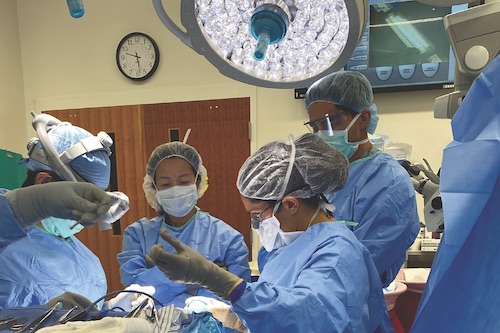Encephalocele / CSF leak
Encephalocele is a condition in which the brain protrudes through a gap in the skull. This protrusion can happen anywhere at the base of the skull, from the nose, the ear, to the back of the head. Encephaloceles can result in leakage of fluid from around the brain, cerebrospinal fluid (aka, CSF leak). This commonly presents as a clear, watery drainage from the front of the nose, the back of the nose (i.e., postnasal drip) or from the ear. These conditions may contribute to hearing loss, dizziness, pulsating noise in the ear and headaches.
At UF Health, patients benefit from a dedicated neurosurgical hospital with leading-edge operating rooms and specialized nursing staff.
Causes
Encephaloceles and CSF leaks can occur in both adults and children.
Encephaloceles and CSF leaks in adults can occur spontaneously or stem from trauma or prior surgery along the skull base. They are also tied to hydrocephalus, a buildup of CSF pressure in the brain, and pseudotumor cerebri, a less serious increase in pressure around the brain. Obesity and obstructive sleep apnea are associated with increased risk of CSF leaks and encephaloceles.

In children, encephaloceles are usually due to a birth defect. These are relatively rare, occurring in just 1 in every 10,500 babies born in the United States. The exact cause for the birth defect that leads to encephaloceles in children is unknown, but scientists believe that many factors are involved. There is a genetic (inherited) component to the condition, meaning it often occurs in families that have family member-related defects, such as spina bifida and anencephaly. Certain environmental exposures before or during pregnancy might also be causes, but more research is needed.
Symptoms
Encephaloceles and CSF leaks can affect the ear, paranasal sinuses or nose. Accordingly, they are commonly found when a patient presents with ear and nasal complaints, such as ear fullness, hearing loss, nasal obstruction, and clear watery nasal drainage. Patients who have CSF leaks may experience dizziness and headaches that change with body position. Occasionally, the encephalocele or CSF leak is identified after a patient develops meningitis, a serious infection around the brain.
Treatment
UF Health takes a multidisciplinary team approach to treatment of encephaloceles and/or CSF leak, involving neurosurgery, neurotology, rhinology, neuro-ophthalmology and neurology.
We also have a dedicated neurosurgical hospital with state-of-the-art operating rooms and specialized nursing staff.
Upon arrival at UF Health, a patient is referred to either a neurosurgeon, neurotologist or rhinologist (ENT). Once imaging is reviewed and the diagnosis is confirmed, patients receive an expedited appointment with the rest of the multidisciplinary team to discuss all treatment options available.
Hearing tests can be done the same day and at the same place as the ENT appointment. Necessary high-resolution imaging studies (e.g., CT and MRI scans) can be done the same day and same place as the ENT or neurosurgery appointment.
After thorough discussion with the treating physicians, the patient makes an informed decision regarding treatment options.
UF Health physicians treat encephaloceles and CSF leaks surgically in a variety of ways, but usually with minimally invasive techniques through the ear or the nose.
When necessary, an encephalocele can be treated surgically by gently lifting the brain to repair the underlying defect in the skull base. The specific treatment is determined by the location of the encephalocele or CSF leak, hearing status and other patient-specific factors.
The surgery itself usually takes from 1-4 hours. When surgery is done, initial recovery is usually carried out in the post-anesthesia care unit, or PACU, to closely monitor the nervous system, breathing and heart.
After an hour or two, care is transferred to a nursing station. Patients are watched closely overnight, and many may go home the next morning.
